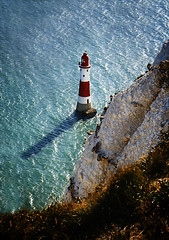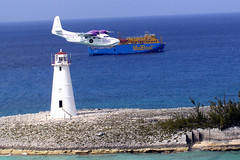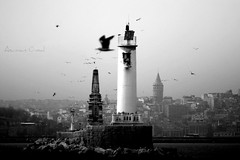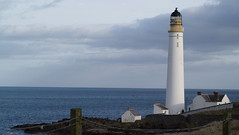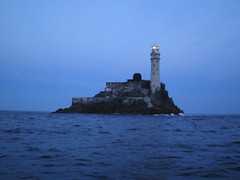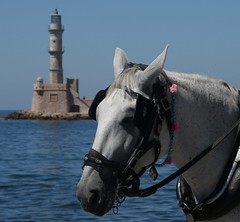20090821
Greece Alexandroupoli
20090819
Beachy Head Lighthouse
Actually, maybe it was bluer.
Beachy Head is the name of the tallest chalk cliff on the south coast.
On a sunny day it's a very pretty spot.
More morosely, it's also a popular suicide spot, which is sad.
I guess if things are bad enough that you're going to jump off a cliff, this at least is a very pretty one...
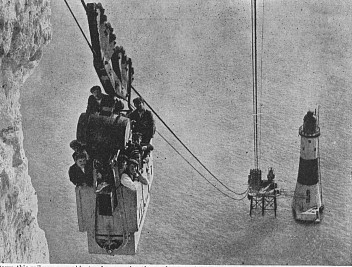
20090818
Split Rock Lighthouse
The structure was designed by lighthouse engineer Ralph Russell Tinkham and was completed in 1910 by the United States Lighthouse Service at a cost of $75,000, including the buildings and the land. It is built on a 130-foot (40 m) sheer cliff of anorthosite. The lighthouse was first lit on July 31, 1910. It was built in response to the loss of ships during the famous Mataafa Storm of 1905, in which 29 ships were lost on Lake Superior.
From Wikipedia, the free encyclopedia
20090817
Hanois Guernsey 11/02/2008
Specifications
| Established | 1862 |
| Height Of Tower | 33 Metres |
| Height Of Light Above Mean High Water | 33 Metres |
| Automated | 1996 |
| Lamp | 35 Watt Metal Arc Lamp |
| Optic | 4th Order Rotating Optic |
| Character | White Group Flashing Twice Every 13 Seconds |
| Intensity | 89,900 Candela |
| Range Of Light | 20 nautical miles |
| Fog Signal Character | Sounding Twice Every 60 Seconds |
| Fog Signal Range | 2 nautical miles |
2010 Calendar
www.trinityhouse.co.uk
20090814
yalancıktan yüzüne gülen dünya
Made in Türkiye
20090813
After the Storm Heceta Head
I appreciated all of the comments before, as this was one of my first photos to post. Fellow "Flickrittes" commented it was a little blurry and lacked depth. It may still lack some depth, but the blurriness was caused from too much compression. I hope you enjoy this one as much as I do. I am hoping to capture this in HDR on a later trip to the coast.
44.13737°N 124.127835°W
Heceta Head Light is a lighthouse located on the Oregon Coast 13 miles (21 km) north of Florence, Oregon and 13 miles (21 km) south of Yachats, Oregon, United States. It is located at Heceta Head Lighthouse State Scenic Viewpoint (a state park) midway up a 205-foot (63 m) tall headland. Built in 1894, the 56-foot (17 m) tall lighthouse shines a beam visible for 21 miles (34 km), making it the strongest light on the Oregon Coast.[1]
The light is maintained by the Oregon Parks and Recreation Department, while the assistant lighthouse keepers' house, operated as a bed and breakfast, is maintained by the U.S. Forest Service. The lighthouse is 2 miles (3.2 km) away from Sea Lion Caves.
20090811
Öreke Taşı Fenerbahçe
20090810
Scurdie Ness for Rebecca
1870 (David and Thomas Stevenson). 19 m (62 ft) brick tower with lantern and gallery
Le phare du Fastnet!
20090805
Tired old horse
35°31′N 24°1′E
Chaniá (Greek: Χανιά, IPA: [xaˈɲa], also transliterated Chania, Hania, and Xania, older form Chanea and Venetian Canea, Ottoman Turkish خانيه Hanya) is the second largest city of Crete and the capital of the Chania Prefecture. It lies along the north coast of the island, about 70 km west of Rethymno and 145 km west of Heraklion.
The official population of the municipal area is 55,838 but around 70,000 people live in the greater area of Chania. With 4,248.1 inhabitants/km², the municipality is the most densely populated outside the Athens and Thessaloniki metropolitan areas.
Lighthouses of the South

Author: Elinor De Wire
Lighthouses are symbolic of many things we cherish: guidance, safety, strength, a light to shine the way in a sea of troubles. These proud old sentries no longer have keepers and many have been upstaged by modern, high-tech navigational methods, but the towers and their dedicated caretakers remain alive in the pages of history. Some sixty five lighthouses still stand in the South, from the Outer Banks of North Carolina to Pensacola, Florida. With informative text and exceptional color photographs, lighthouses authority Elinor De Wire and photographer Daniel E. Dempster take you on a journey through the history of Southern beacons. "Lighthouses of the South" takes a captivating look at not only the lighthouses themselves--structure, interiors, and lenses--but also provides information about the construction of lighthouses, the history of the lighthouse service, stories of keepers and great rescues and wrecks, current preservation efforts, and much more. De Wires lively stories are accented by Dempsters outstanding photographs of lighthouses, interiors, and lenses. The book also includes a bibliography and an appendix that lists all lighthouses of the Southeastern Coast.
Format: Hardbound
Pages: 160
Length: 8.5w x 11h
ISBN-13: 9780896586031
ISBN: 0896586030
Catalog ID: 141372AP
Edgartown Harbor Light
 Edgartown Harbor Light is a lighthouse located in Edgartown, Massachusetts that marks the entrance into Edgartown Harbor and Katama Bay. The lighthouse was originally built in 1828, but it was destroyed in a hurricane in 1938. It was replaced in 1939 with a tower relocated from Ipswich, Massachusetts.
Edgartown Harbor Light is a lighthouse located in Edgartown, Massachusetts that marks the entrance into Edgartown Harbor and Katama Bay. The lighthouse was originally built in 1828, but it was destroyed in a hurricane in 1938. It was replaced in 1939 with a tower relocated from Ipswich, Massachusetts.The Martha's Vineyard Historical Society has been the caretaker of the lighthouse since 1993, although the United States Coast Guard owns the structure. The society is currently in the process of restoring the lighthouse. Improvements include replacing boarded-up windows and installing a spiral staircase, with the goal of opening the lighthouse to public access.
edgartown
nps.gov
Hólmaberg ...
Just to give you some idea on the proportions in this frame I would guess that the lighthouse is a at least 10m high.
The image: HDR of 2.5s, 10s and 30s exposures at f10 with contrast enhancements in Photoshop.



